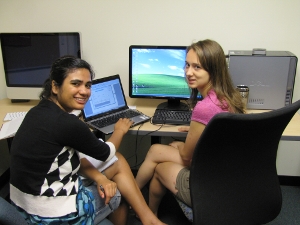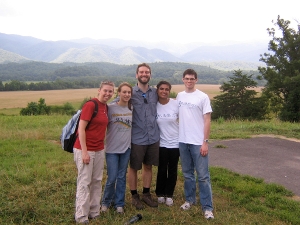EcoEd Webinar
Math, Computing, Undergraduate Ecology Education and Large Datasets: An Example from a Citizen Science Program
 Objectives: This interactive webinar, sponsored by NIMBioS and the Ecological Society of America (ESA), focuses on math and computational education for ecology undergrads and illustrates how a large field dataset can be used to motivate hypothesis formulation and assessment by undergraduates. This includes a discussion of NIMBioS’ Research Experience for Undergraduates (REU) program linking biology and math undergrads; discussion of a large citizen science project based in the Great Smoky Mountains National Park (Discover Life in America's All Taxa Biodiversity Inventory – ATBI); description of one ATBI large biodiversity dataset and how a small group of undergrads chose what to analyze and how to do so; and interview comments from the REU students about their learning process. We emphasize how the data and analysis involved a multiplicity of concepts of biodiversity, the variety of questions raised by the students and the constraints on addressing them using the available data.
This webinar is offered as one of several events prior to the
Ecology and Education Summit, sponsored by ESA and the National Education Association, to be held Oct. 14-15, 2010, in Washington.
The webinar was held from 1 - 1:45 p.m. EDT, Wednesday, Sept. 8, 2010.
Objectives: This interactive webinar, sponsored by NIMBioS and the Ecological Society of America (ESA), focuses on math and computational education for ecology undergrads and illustrates how a large field dataset can be used to motivate hypothesis formulation and assessment by undergraduates. This includes a discussion of NIMBioS’ Research Experience for Undergraduates (REU) program linking biology and math undergrads; discussion of a large citizen science project based in the Great Smoky Mountains National Park (Discover Life in America's All Taxa Biodiversity Inventory – ATBI); description of one ATBI large biodiversity dataset and how a small group of undergrads chose what to analyze and how to do so; and interview comments from the REU students about their learning process. We emphasize how the data and analysis involved a multiplicity of concepts of biodiversity, the variety of questions raised by the students and the constraints on addressing them using the available data.
This webinar is offered as one of several events prior to the
Ecology and Education Summit, sponsored by ESA and the National Education Association, to be held Oct. 14-15, 2010, in Washington.
The webinar was held from 1 - 1:45 p.m. EDT, Wednesday, Sept. 8, 2010.
You can view the webinar in its entirety by clicking the links below:
Video and audio to view in web browser (PC works best for this option)
Audio only (.wav format)
PDF version of the slideset presented
Presenters:
William Godsoe (NIMBioS) and
Louis Gross (Univ. of Tennessee/NIMBioS)
Selected References:
- Brewer, C. A. & Gross, L. J. 2003. Training ecologists to think with uncertainty in mind. Ecology 84:1412-1414. [Online]
- Hilborn, R. & Mangel, M. 1997. The ecological detective: confronting models with data. Princeton University press.
- Legendre, P. & Gallagher, E. D. 2001. Ecologically meaningful transformations for ordination of species data. Oecologia 129: 271-280.
- Orloci, L. 1967. An agglomerative method for classification of plant communities. Journal of Ecology 55: 193-206.
- Whittaker, R. H. 1952. A study of summer foliage insect communities in Great Smoky Mountains National Park. Ecological Monographs 22: 2-44.
Recommended Websites:
R programming language
Vegan package for r (for community ecology)
R for biologists (NIMBioS Tutorial)
William Godsoe research page
All Taxa Biodiversity Inventory
Great Smoky Mountains National Park
Vision and Change in Undergraduate Biology Education: A View for the 21st Century
BIO2010: Transforming Undergraduate Education for Future Research Biologists (2003)
Scientific Foundations for Future Physicians. AAMC-HHMI Report 2009.
Binomial test (Wikipedia article)
NIMBioS
Click on the podcasts below to hear William Godsoe's interviews with participants in the NIMBioS' 2010 Research Experiences for Undergraduates. Dr. Godsoe was one of the REU mentors.

|
|
Samrachana Adhikari, Mount Holyoke College

|
|
Jillian Trask, University of Tennessee graduate student in math, former math teacher at Bearden High School, Knoxville, TN
Students from REU Group who worked on the project Biodiversity in the Great Smoky Mountains National Park.

|

| |
| (From left) Samrachana Adhikari, Kelly Geyer | (From left) Jillian Trask, Kelly Geyer, William Godsoe, Samrachana Adhikari, David Bulger |
NIMBioS
1122 Volunteer Blvd., Suite 106
University of Tennessee
Knoxville,
TN 37996-3410
PH: (865) 974-9334
FAX: (865) 974-9461
Contact NIMBioS


